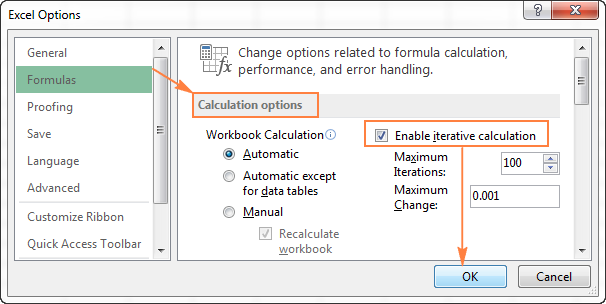- How To Enable Manual Iteration On Excel Mac 2011 Review
- How To Enable Manual Iteration On Excel Mac 2011 Cell Border
How To Enable Manual Iteration On Excel Mac 2011 Review
How To Enable Manual Iteration On Excel Mac 2011 Cell Border
Summary
How to turn off function argument ToolTips in Microsoft Excel 2002 and in Microsoft Excel 2003
- On the Tools menu, click Options.
- In the Options dialog box, click the General tab.
- Click to clear the Function tooltips check box, and then click OK.
How to turn off function argument ToolTips in Microsoft Office Excel 2007
- Click the Microsoft Office Button, click Excel Options, and then click Formulas.
- Click to clear the Formula AutoComplete check box.
- Click the Microsoft Office Button, click Excel Options, and then click Advanced.
- In the Display area, click to clear the Show function ScreenTips check box.
You've entered a formula, but it’s not working. Instead, you’ve got this message about a “circular reference.” Millions of people have the same problem, and it happens because your formula is trying to calculate itself, and you have a feature called iterative calculation turned off. Here's what it looks like:
The formula =D1+D2+D3 breaks because it lives in cell D3, and it’s trying to calculate itself. To fix the problem, you can move the formula to another cell (in the formula bar, press Ctrl+X to cut the formula, select another cell, and press Ctrl+V).
Another common mistake is using a function that includes a reference to itself; for example, cell F3 contains =SUM(A3:F3). Here's an example:
You can also try one of these techniques:
- If you just entered a formula, start with that cell and check to see if you refer to the cell itself. For example, cell A3 might contain the formula =(A1+A2)/A3. Formulas like =A1+1 (in cell A1) also cause circular reference errors.
While you're looking, check for indirect references. They happen when you put a formula in cell A1, and it uses another formula in B1 that in turn refers back to cell A1. If this confuses you, imagine what it does to Excel.
- If you can't find the error, click the Formulas tab, click the arrow next to Error Checking, point to Circular References, and then click the first cell listed in the submenu.
- Review the formula in the cell. If you can't determine whether the cell is the cause of the circular reference, click the next cell in the Circular References submenu.
- Continue to review and correct the circular references in the workbook by repeating steps any or all of the steps 1 through 3 until the status bar no longer displays 'Circular References.'

If you're brand new to working with formulas, see Excel 2016 Essential Training at LinkedIn Learning.
Learn about the circular reference warning message
The first time Excel finds a circular reference, it displays a warning message. Click OK or close the message window.
When you close the message, Excel displays either a zero or the last calculated value in the cell. And now you're probably saying, 'Hang on, a last calculated value?' Yes. In some cases, a formula can run successfully before it tries to calculate itself. For example, a formula that uses the IF function may work until a user enters an argument (a piece of data the formula needs to run properly) that causes the formula to calculate itself. When that happens, Excel retains the value from the last successful calculation.
